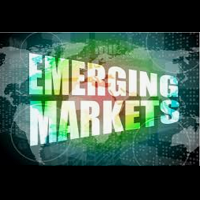Fidelity Emerging Markets Limited (LON:FEML) is the topic of conversation when Co-Portfolio Manager Christopher Tennant caught up with Fidelity International’s Head of Investment Companies Claire Dwyer for an exclusive interview.
Q1: So, it’s been a challenging period for emerging market strategies, pretty much across the board. To what extent do you think the market’s being led by sentiment rather than fundamentals?
A1: It’s obviously been an incredibly tough last 12 months for emerging market equities due to a confluence of factors.
Firstly, you’ve had the global inflationary pressures driving a tighter monetary cycle in the US and elsewhere. You’ve had the war in the Ukraine and global fears around a recession coming in various development market. Then, you’ve had a lot of country-specific issues in China as well with extended COVID lockdowns pressuring the economy and also regulatory headwinds for both the tech sector through regulation and also the property sector with an ongoing tightening cycle, particularly in the first half of last year.
All of these factors have put enormous pressure on emerging market equities so that has harmed the fundamentals and driven a large derating as sentiment has deteriorated.
Q2: As an investor, you’re very much focussed on well capitalised businesses with under levered balance sheet. Where are you seeing the best opportunities at the moment?
A2: Probably the sector today where we’ve seen the most opportunities and one we have been adding exposure throughout the last 12 months is in the financial space. The higher interest rate environment driven by the Fed and central banks around the world is also a trend that we see in emerging markets and this, for the financial space, particularly for the banks, is a big tailwind for earnings.
Most recently in Europe, you’ve seen the ECB turn more hawkish and that has been a positive sentiment towards some of the emerging European banks where we have exposure to.
Another example would be in Latin America where we have exposure to Peru via Credicorp, this is a dominant deposit taking franchise with about 40% market share in the country, of deposits As interest rates have risen, you’ll that repriced in their loan portfolio and that will drive margin expansion for this bank. At the same time, they’re able to generate high single-digit, low double-digit loan growth so you have positive volume trends as well.
These financials across emerging markets are offering extremely attractive valuations, high dividend yields and seeing earnings upgrades so that’s an area where we see a lot of opportunities.
Q3: Chris, what about the energy sector?
A3: Energy is another area where we have a constructive view on the commodity backdrop, we think that energy prices and quantity prices in general will stay higher for longer.
The challenge in emerging markets is that higher commodity basket doesn’t always translate into returns for minority shareholders. When the energy company is a state-owned enterprise, there’s a lot of political and regulatory interference, hiking in tax rates etc. so it’s very difficult to get exposure to energy through emerging market listed assets.
Instead, Fidelity Emerging Markets own some DM listed energy producers with their asset portfolio being based in emerging markets. So, a couple of examples there would be Tata, which is obviously listed in France and OMV, an Austrian listed business. Both of these companies have extremely attractive valuations, high quality portfolio and much higher standards of corporate governance than you’ll find in some of the EM SOEs.
So, it’s an area where we have exposure to through some of the developed market listed businesses that I’ve mentioned.
Q4: What about IT Materials?
A4: Again, IT is an area where there’s a fantastic array of opportunities. Where we’ve been adding exposure most recently is in the internet space, in China, and these businesses have derated to valuations that we’ve never seen before.
The fundamental outcome in the short term will remain quite challenging but we think we’ve past the worst in terms of regulation. There are signs that the regulator in China is becoming more favourable to the sector, and as I mentioned the valuations are extremely cheap. So, that’s an areas where we’re adding exposure to and we see a lot of attractive opportunities.
Conversely, the Trust has the ability to short, and there are plenty of areas in the IT space that are going to be extremely challenged for the next couple of years.
One of the impacts from COVID and lockdowns was it dragged forward a lot of demand for consumer electronics. So, everyone was stuck at home, they bought new Notebook computers, that sort of thing, so the companies that manufacture these items are seeing volumes decline and, at the same time, the consumer globally is under a lot of pressure.
So, a whole range of demand headwinds being faced by this sector and there’s plenty of opportunities to short some of these businesses that are going to struggle for volumes over the next couple of years.
Q5: What about the portfolio on a country level, how’s it looking?
A5: So, the country exposure, we have a much higher breadth of country exposure. If you were to look at the country bets today, they would be much lower than they have been historically for this strategy. That’s a bit of function of the heightened geopolitical risks globally, we take a more cautious view on country exposure and that’s reflected in the portfolio.
Q6: Chris, what about the tools that are specific to investment trusts, and how do they work with the Fidelity Emerging Markets strategy that you’re managing?
A6: For this investment trust, there are three main tools that allow the strategy to differentiate from a long-only product.
Firstly is the ability to go further down the market cap spectrum, the size of the trust and its closed-ended nature allow us to invest more in mid-caps than you would do in a larger open-ended strategy. The fact that Fidelity has over 250 research professionals and about 60 of them providing sector coverage for emerging markets means we can have waterfront coverage of not just large cap ideas but small and mid-cap as well. That’s where some of the most exciting opportunities lie, particularly in recent years we’ve seen a huge derating in some of the mid-caps space.
Secondly, is the ability to short. The majority of the short book is made up of pair trades so if we own a winning company within a certain sub sector, we will look for losers within that same space, and most likely a company that’s losing market share with a negative fundamental backdrop. We’ll look for these businesses as well where they have concerns around either accounting, corporate governance, broken balance sheet, that short of thing, so these are really dying businesses that we look to short in the strategy and take advantage from their declining outlook.
Thirdly, the strategy has the ability to use options. This is not a risk-taking speculative pursuit but we use the option book to hedge risk and this typically involves selling call options against long positions, and selling put options against short positions. It reduces the overall risk and volatility of the portfolio and provides an income stream at the same time where we target adding about 100 pips per annum to the strategy in terms of performance.
Q7: What about your net market exposure at the moment, where’s that sitting?
A7: We manage the net exposure quite closely to 100 at all times, in an absolute basis and we’ll look at a beta-adjusted net exposure as well, and we’ll always keep that fairly close to 100.
At the moment, it’s between 102-103, towards the upper end of the range, and the reason for that is we see a lot of compelling opportunities on the long side, given some of the issues that we’ve mentioned around deteriorating sentiment and the market being extremely cheap, there’s lot of opportunities today in EM.
Q8: We’re in 2023 now, what do you think investors should be focussed on as we go through this year?
A8: I think one of the most important drivers for emerging market, and markets generally, has been the interest rate cycle and I think what we see today is signs of inflation easing, both in developed markets and emerging markets.
So, the peak in interest rate hiking cycle in the US is within our horizon now, and that has been a huge burden for emerging markets that need to fund their deficits externally. It’s put a huge pressure on a lot of emerging market economies, and we’re coming to the end of that situation today.
I think what’s different in this cycle versus prior cycles is that a lot of emerging market central banks have been well ahead of the curve in terms of hiking interest rates extremely aggressively and you see positive real rates, positive carry in a lot of emerging markets today, which hasn’t been the case in prior cycles.
So, I think EM is extremely well positioned to benefit when we do reach that peak interest rate from the Fed and that’ll be a big tailwind for EM asset classes.
Another key theme faced by emerging markets is the commodity environment, I think that the outlook remains extremely positive. We’ve had a decade of under investment in both energy assets and metals & mining assets, and so I think as China reopens, that’s a big boost for demand for certain commodities. At the same time, they supply side has been starved of capital, as I mentioned, for the last 10 years or so, so the supply/demand outlook for commodities is extremely positive and that will benefit commodity exporting nations such as Brazil, Mexico, South Africa, and be a big boost for these economies.
So, there are opportunities not just in the commodity producing companies but also the consumer in these exporting nations will also stand to benefit so there are opportunities there as well.



